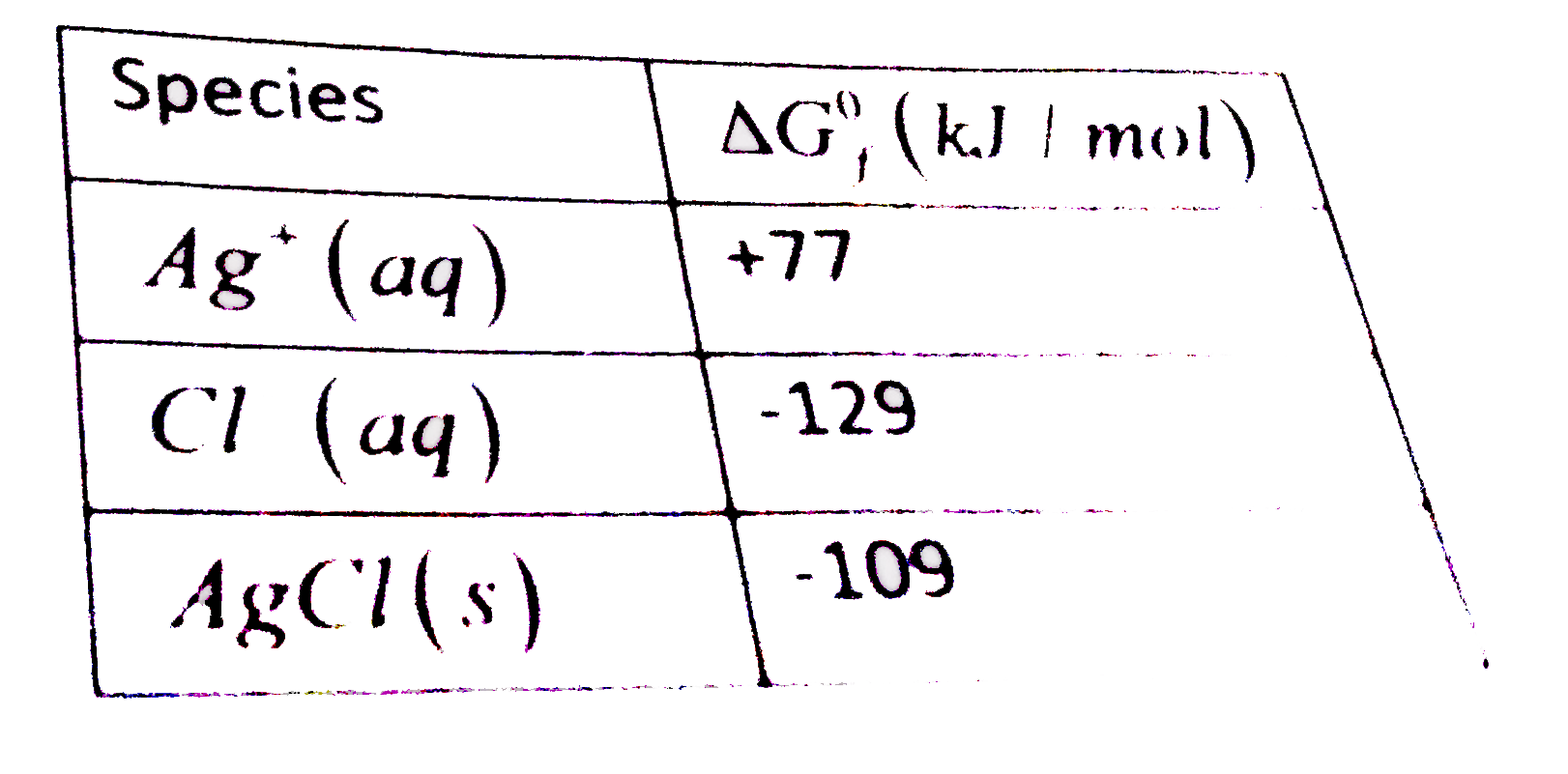In an experiment, 6.539×10−2g of metallic Zn (M = 65.39) was added to 100 mL of saturated solution of AgCl. Calculate log[Zn2+]/[Ag+]2, given that: Ag++e→Ag, E∘=0.80V,
Zn2++2e→Zn,E∘=−0.78
Also calculate the number of moles of Ag formed.Solution in Bengali
Half - cell reactions are -
Ag+(aq)+e → Ag(s) Ag(s)+Cl−(aq) → AgCl(s)+e¯¯¯¯¯¯¯¯¯¯¯¯¯¯¯¯¯¯¯¯¯¯¯¯¯¯¯¯¯¯¯¯¯¯¯¯¯¯¯¯¯¯¯¯¯¯¯¯¯¯¯¯¯¯¯¯¯¯¯¯¯¯¯¯¯¯¯¯¯¯¯¯¯¯¯¯¯¯Cell reaction: Ag+(aq)+Cl−(aq)→AgCl(s)
Amount of zinc added =6.539×10−265.39=10−3 mol
Therefore, the following reactions will occur :
( 2Ag+(aq)+2e → 2Ag(s),),( Zn(s) → Zn2+(aq)+2e,),(¯¯¯¯¯¯¯¯¯¯¯¯¯¯¯¯¯¯¯¯¯¯¯¯¯¯¯¯¯¯¯¯¯¯¯¯¯¯¯¯¯¯¯¯¯¯¯¯¯¯¯¯¯¯¯¯¯¯¯¯¯¯¯¯¯¯¯¯¯¯¯¯¯¯¯¯¯¯¯¯¯2Ag+(aq)+Zn(s) → Zn2+(aq)+2Ag(s),)
∴ E∘=(0.059)logK or, −0.59=0.0591logKsp
or, logK_(sp)=-(0.59)/(0.059)thereforeKsp=10−10
Solubility of AgCl in 0.1 M AgNO3=S(S+0.1)
∴ S(S+0.1)=10−10 or, S=10−9M
∴ Amount of AgCl dissolved in 109L solution = 1 mol.
∴ Amount of AgCl that dissolves in 106L of the solution
=1109×106=10−3mol = 1.0 mmol
Topper's Solved these Questions
- BOOK - CHHAYA PUBLICATIONCHAPTER - ELECTROCHEMISTRYEXERCISE - ENTRANCE QUESTION BANK (WBJEE)14videos
ELECTROCHEMISTRY
- BOOK - CHHAYA PUBLICATIONCHAPTER - ELECTROCHEMISTRYEXERCISE - ENTRANCE QUESTION BANK (JEE-MAIN)10videos
ELECTROCHEMISTRY
- BOOK - CHHAYA PUBLICATIONCHAPTER - ELECTROCHEMISTRYEXERCISE - HIGHER ORDER THINKING SKILL (HOTS) QUESTIONS30videos
ELECTROCHEMISTRY
- BOOK - CHHAYA PUBLICATIONCHAPTER - D - AND F - BLOCK ELEMENTS EXERCISE - PRACTICE SET 8 (Answer the following questions)10videos
D - AND F - BLOCK ELEMENTS
- BOOK - CHHAYA PUBLICATIONCHAPTER - ENVIRONMENTAL CHEMISTRYEXERCISE - PRACTICE SET 14(Answer the following questions)6videos
ENVIRONMENTAL CHEMISTRY
Similar Questions
On passing 'c' ampere of current for time 't' s through 1 L of 2(M) CuSO4 solution (atomic mass of Cu = 63.5), the amount 'm' of Cu (in g) deposited on cathode will be -
11:54View SolutionWhat amount of electricity can deposit 1 mol of Al metal at cathode when passing through molten AlCl3-
08:41View SolutionArrange H2CO3 (carbonic acid), glucose, sodium chloride and hydrochloric acid solution, each of 0.1 (M) concentration, in ascending order of their molar conductivity.
View SolutionWhy are most transition metal ions paramagnetic ?
View SolutionWhat is hypothermia?
08:41View Solution6.537 xx 10^(-2)f of metallic Zn was added to 100 mL of saturated solution of AgCl . Calculate log .([Zn^(2+)])/([Ag^(o+)]) . Given : E^(c-)._(Ag^(o+)|Ag)=0.80V, E^(c-)._(Zn^(2+)|Zn)=-0.763V . K_(sp) of AgCl~~10^(-10), atomic weight of Zn=65.37
03:41View Solutiona. For the reaction
Given : Ag⊕(aq)+Cl⊕(aq)→AgCl(s)

Write the cell representation of above reaction and calculat E∘cell at 298K.
Also find the solubility product of AgCl.
b. If 6.539×10−2g of metallic zinc is added to 100ml saturated solution of AgCl. Find the value of
log10.[Zn2+][Ag+]2
How many moles of Ag will be preciptated in the above reaction. Given that
Ag++e−→Ag,E∘=0.80V
Zn2++2e−→Zn,E∘=−0.76V06:39View SolutionThe SOP , E∘ for the half reactions are
Zn→Zn2++2e,E∘=+0.76V
Ag→Ag++e,E∘=−0.77V
E∘ of the cell , Ag++Zn→Zn2++Ag is :02:15View Solution(a) Calculate △G0f of the following reaction
Ag+(aq)+Cl−(aq)→AgCl(s)
given △G0f (AgCl) =−109kJ/mole,
_f△G0(Cl−)=−129kJ/mole
_f△G0(Ag+)=77kJ/mole
represent the above reaction in from of a cell. Calculate E0 of the cell. Find log10KSP of AgCl
(b) 6.539×10−2 g of metallic Zn (amu = 65.39) was added to 100 ml of saturated solution of AgCl.
Calculate log10([Zn2+][Ag+]2) ,given that
Ag++e−→AgE0=0.80V , Zn2++2e−→ZnE0=−0.76V
Also find how many moles of Ag will be formed?03:06View Solutiona. For the reaction
Given : Ag⊕(aq)+Cl⊕(aq)→AgCl(s)

Write the cell representation of above reaction and calculat E∘cell at 298K.
Also find the solubility product of AgCl.
b. If 6.539×10−2g of metallic zinc is added to 100ml saturated solution of AgCl. Find the value of
log10.[Zn2+][Ag+]2
How many moles of Ag will be preciptated in the above reaction. Given that
Ag++e−→Ag,E∘=0.80V
Zn2++2e−→Zn,E∘=−0.76V04:53View SolutionAt 20^(@) C, the standard oxidation potential of Zn and Ag in water are: Zn(s)rarr Zn^(2+) (aq) + 2e^(-), E^(o) = 0.76V , Ag(s) rarr Ag^(+)(aq) + E^(-) , E^(o) = - 0.80 V The standard EMF of the given reaction is: Zn+2Ag^(+)rarr 2AG+Zn^(+2)
05:05View SolutionThe standard oxidation potentials of Zn and Ag in water at 25∘C are
Zn(s)→Zn2++2e,E∘=0.76V
Ag(s)→Ag++e,E∘=−0.80V
Which reaction actually takes place ?View SolutionAg++e−→Ag,E0=+0.8VandZn2++2e−→Zn,E0=−076V. Calculate the cell potential for the reaction, 2Ag+Zn2+→Zn+2Ag+
03:15View SolutionThe standard reduction potentials of Zn and Ag in water at 298 K are, Zn2++2e−→Zn,E∘=−0.76V and
Ag++e−→Ag,E∘=+0.80V
Which of the following reactions take place?02:43View SolutionIf E∘(Zn/Zn2+)=+0.76V, E∘(Ag+/Ag)=+0.80V, find the emf of the cell -Zn/Zn2+(0.01M)||Ag+(0.1M)/Ag.
02:52View Solution

